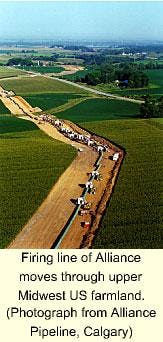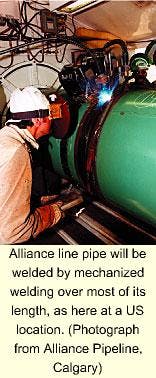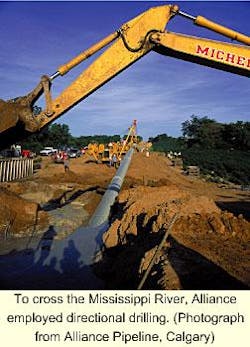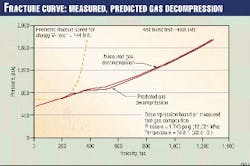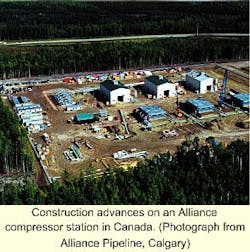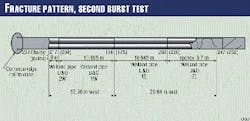Full-scale burst tests performed on line pipe typical for that being installed on the Canadian-US Alliance project have validated fracture control for the pipeline system.
The tests demonstrated that under typical worst-case operating conditions, should fractures occur, they will quickly arrest.
BC to Illinois
Alliance Pipeline is constructing a $3 billion (Canadian $4.5 billion) natural gas pipeline system from northeastern BC to the Chicago, Ill., market center or "hub" where it will interconnect with the North American pipeline grid.
The Alliance Pipeline Ltd. Partnership consists of affiliates of Duke Energy Corp., Charlotte, NC, 9.8%; Enbridge Inc., Calgary, (the former Interprovincial Pipeline, 21.4%; Fort Chicago Energy Partners LP, Calgary, 26.0%; Coastal Corp., Houston, 14.4%; Williams Cos., Tulsa, 4.8%; and Westcoast Energy Inc., Vancouver, 23.6%.
Alliance Pipeline will have an initial firm throughput volume of 1.325 bcfd (37.5 million cu m/day) of high-energy natural gas. It pushes many new frontiers in design, construction, and operation of its 1,858-mile mainline system.
These include:
- High-toughness line pipe, greater than 140 ft-lb Charpy energy.
- High operating pressure of 1,740 psig maximum.
- Rich gas: The maximum heating value will be 1,188 btu/std. cu ft; Table 1 provides the gas composition.
- First use of mechanized field welding in the US on a major cross-country pipeline
- Baseline in-line inspection within the first 5 years of operation.
The 2-year construction of the mainline began in March 1999 in Canada and in May 1999 in the US. It will be completed in fall 2000.
The Canadian portion of the system will consist of 340 km (212 miles) of 1,067 mm (42-in.) and 1,220 km (758 miles) of 914 mm (36-in.) OD steel line pipe with seven mainline compressor stations of 31,000-40,000 hp (23 to 29 Mw) each, spaced about 120 miles (193 km) apart.
The Canadian gathering system will add 770 km (480 miles) of smaller diameter lines to connect to individual gas plants. All gas received will have been processed to remove impurities.
The US portion of the system will consist of 888 miles (1,429 km) of 36-in. (914 mm) OD steel line pipe with seven compressor stations of about 31,000 hp (23 Mw) each, spaced 120 miles (193 km) apart. The pipeline generally parallels existing rights-of-way for most of its length.
The 36-in. OD line pipe produced for the project is being fabricated from X-70 steel (CSA Gr. 483 in Canada) with carbon levels of 0.04 to 0.06, manganese levels of 1.4-1.8, with additions of vanadium, columbium, and molybdenum. The steels are low sulfur (0.001 to 0.006%) and low phosphorus (0.007 to 0.012%).
Very tight controls on steel chemistry and rolling procedures have produced actual toughness results greater than what has been traditionally required for North American pipelines. For example, the 36-in. line pipe in Canada has toughness levels with all-heat-average Charpy energy levels at 23° F. (-5° C.) of approximately 240 ft-lb (328 Joules).
Fracture control
One of the issues in design and in regulatory hearings was fracture control. These issues concern the flaw tolerance of the pipe before a rupture occurs and the ability of the pipe to arrest a propagating axial fracture if one should initiate.
There was debate in the regulatory hearings over the combination of the pressure, rich gas, and pipe diameter as to whether the fracture toughness predicted for arrest would indeed ensure fracture arrest.
The prediction equations used are empirical. Therefore, when a new pipeline pushes the envelope of existing experience, full-scale burst tests are desirable to validate the fracture-arrest design.
Defect lengths that the Alliance 36 and 42-in. OD pipes can tolerate as a leak before fracture initiation occurs are nominally 6-in. long flaws completely through the wall thickness, according to Alliance Fracture Control Plans filed with the US Federal Energy Regulatory Commission.1
This fracture-initiation defect tolerance is excellent and represents the maximum defect lengths that pipe of this size and grade can tolerate. Although the Alliance pipe has this excellent fracture-initiation tolerance, it was assumed that a fracture might occur in service. Therefore, fracture arrest had to be validated.
Full-scale burst tests on typical project pipe were conducted to validate that fracture arrest is ensured by the toughness specified for the line pipe. Two burst tests were conducted on 36-in. OD pipe with the first validating arrest in the 36-in. OD pipe and the second validating arrest in the 42-in. OD pipe.
The burst tests were conducted by B.G. Technology's Mike Johnson and Keith Armstrong at its Spadeadam (UK) test site. The test design was developed by a team of experts including the authors to ensure that the test would subject the fractures to pressure levels (driving forces) that are the same as would be experienced in a long pipeline.
The burst tests involved 10 pipe joints welded end-to-end and inserted into a 1,200-ft long pipeline.
The design concept was to place two pipe joints with relatively low toughness levels in the center of the test section. The initiation of the fracture across the weld between these two low-toughness joints ensured the generation of high-speed propagating fractures entering the adjacent test joints.
These adjacent test joints were arranged to become progressively tougher, in order to determine what toughness was required to stop the high-speed fractures. Arresting these high-speed fractures is necessary to prove that the arrests are valid and applicable to an operating pipeline.
The steel toughness levels required for fracture arrest were predicted for Alliance with the PRCI Battelle-developed fracture arrest equations and the Gasdecom2 and the Picard and Bishnoi3 gas decompression equations. (The gas-decompression prediction results for both equations were similar.)
The calculated Charpy energy values from the Battelle equations were greater than 75 ft-lb, which is the demarcation line of a 1:1 correspondence of Charpy energy to fracture arrest behavior. The authors had learned from previous work that at greater than this level, the Charpy test under predicts the required fracture-arrest toughness of the line pipe.
To correct for this, B. Leis, Battelle, developed a deviation or correction factor for the Alliance project.4 This factor was 1.24 for the first test and 1.28 for the second.
The significance of this correction is that the line pipe was predicted to require 24% greater toughness than predicted by the original Battelle model for the first test and 28% for the second test. The predicted toughness levels for arrest in the pipeline were 141 ft lb and 158 ft-lb, respectively, for 36 and 42-in. OD lines.
First burst test
The first burst test involved 1,200 ft of 36-in. OD x 0.560-in. WT X-70 pipe at 1,743 psig and 75° F. The pipe lengths were arranged from the center toward each end with increasing fracture toughness.
The Charpy energy level predicted for arrest was 150 ft-lb because of the slightly higher gas pressure and the test-gas composition having a slightly higher heat content than the richest case ever envisioned for the pipeline. The fracture was initiated across the girth weld between the initiator pipes using one 3-ft long shaped explosive charge.
As expected, the fractures that initiated were ductile. (The steel is tested for ductility with the drop-weight-tear-test shear area.) The fractures initially accelerated up to speeds of 1,080 fps (330 m/sec) and then decelerated.
The fractures arrested after propagating 49 ft (14.9 m) to the east and 47 ft (14.3 m) to the west from the point of initiation. Fig. 1 shows the fracture pattern with the pipe shown as if split along the bottom and opened up flat to show the complete fracture pattern in two dimensions.
The fracture arrested on the east in a spiral weld pipe with a Charpy energy of 165 ft-lb (223 Joules) and on the west in a straight seam pipe with a Charpy toughness of 175 ft-lb (237 Joules).
One of the key factors in this test was the rich natural gas. Gas this rich does not remain entirely as a gas during the rapid expansion, which results from a rupture.
As gas vents, the pressure drops and the gas cools, causing it to drop out liquid particles in a process that slows the decompression and requires a higher Charpy energy for fracture arrest.
Fig. 2 shows the measured and predicted gas decompression curves. The discontinuity or offset portion of the curve is the result of the rich gas. If the gas had been a typically lean pipeline gas, the decompression curve would have followed a smooth curve.
The predicted and measured curves are in good agreement, particularly in the region below the discontinuity where the fracture curve connects with the gas decompression. The agreement indicates an extension in the capability of the GASDECOM program2 to calculate gas decompression.
The fracture curve is J shaped to the left of the decompression curves. This curve is for a Charpy energy of 141 ft-lb and, being tangent to the decompression curve, is the predicted toughness dividing propagate and arrest; that is, a lower toughness pipe would have a lower curve where the fracture can keep up with the gas decompression.
For a higher toughness joint, the decompression wave would outrun the fracture and the fracture stops because there is not enough pressure behind the opening pipe flaps to drive it.
This test verified that the design toughness for the Alliance 36-in. OD pipeline will provide fracture arrest in the 36-in. OD portion of the pipeline. The 36-in. OD pipe (in Canada) has been specified to have an all heat average Charpy energy of 206 ft-lb which ensures that all pipe lengths will be arrest lengths.
The actual production pipe has averaged 240 ft-lb, much tougher than the specification. In the US mainline, the pipeline code requires thicker pipe that has lower stress levels and requires less toughness to arrest fractures.
The US mills, however, have also produced pipe much tougher than that specified.
Second burst test
The objective of the second burst test was to validate fracture arrest in the 42-in. OD portion of the pipeline. Because Spadeadam does not have a 42-in. OD test bed with long reservoirs, the test was conducted on all straight-seam 36-in. OD pipe.
The test was designed to require the same arrest toughness as in the 42-in. mainline pipe, 159 ft-lb. To require this level of toughness for arrest, the test pressure was slightly elevated and the temperature decreased to less than that of the first test.
The result was that the second test was conducted at 1,752 psig, 61.7° F. and with a 1,194 btu/std. cu ft gas composition. The predicted Charpy energy for arrest was 164 ft-lb.
The test arrangement resembled the first test with the intiation pipe lengths lower in toughness than predicted for arrest. All of the pipe that fractured in this test was straight seam pipe.
The ductile fractures accelerated as in Test 1 reaching high speeds then slowing and arresting after propagating 67.7 ft to the east and 42.3 ft to the west for a total length that is a few feet longer than in the first burst test. The fracture pattern in burst Test 2 is shown in Fig. 3 (again with the pipe shown as though split along the bottom and opened up flat to show the complete fracture pattern in two dimensions).
This test verified that fracture arrest is ensured in the 42-in. OD pipe since it is being purchased with a minimum all-heat average Charpy energy of 158 ft-lb, and arrest in the test occurred in pipe with 160 ft-lb toughness.
The adequacy of the 42-in. fracture arrest is also being verified by a test of the fracture resistance of larger full thickness test specimens, in addition to the traditional Charpy tests.
References
- Carlson, L., Gilroy-Scott, A., and Horner, W.N., "The Alliance U.S. Fracture Prevention and Control Program," Mar. 6, 1998, submitted to the US Federal Energy Regulatory Commission, Mar. 9, 1998.
- Eiber, R.J., Bubenik, T.A., and Maxey, W.A., "Fracture Control Technology for Natural Gas Pipelines," PRCI AGA Catalog No. L51691, December 1993, pp. 60-74.
- Picard, D.J., and Bishnoi, P.R., "The Importance of Real-Fluid Behaviour and Nonisentropic Effects in Modelling Decompression Characteristics of Pipeline Fluids for Application in Ductile Fracture Propagation Analysis," Can. J. Chem. Eng, Vol. 66 (1999), pp. 3-12.
- Leis, B.N., Eiber, R.J., Carlson, L., and Gilroy-Scott, A., "Relationship Between Apparent Charpy Vee-Notch Toughness and the Corresponding Dynamic Crack-Propagation Resistance," ASME International Pipeline Conference, Calgary, 1998, p. 723.
The Authors
Bob Eiber is principal of Robert J. Eiber, Consultant Inc., Columbus, Ohio, which he founded in 1995 after retiring from Batelle. He holds an MS and BS in civil engineering from Case Western University, Cleveland, Ohio.
Brian Leis is a manager of pipeline research for Battelle, Columbus, Ohio, in its energy products division. He joined Battelle's engineering mechanics group in 1974. Leis holds BASc, MASc, and PhD degrees in civil engineering from the University of Waterloo (Canada).
Lorne E. Carlson is a senior engineer with Alliance Pipeline. He was formerly the chief engineer for LEC Engineering Ltd. He holds an engineering degree from the University of Alberta and a PhD from the University of Toronto and is a registered engineer in Alberta.
W. Norval Horner is manager of facility engineering for Alliance Pipeline Ltd. Partnership, Calgary. He is a registered professional engineer in BC, Alberta, and Saskatchewan. He has a bachelors degree in chemical engineering from the University of Saskatchewan and a MEng from the University of Calgary.
Alan Gilroy-Scott is manager for materials engineering and quality management for the Alliance Pipeline project. From 1986 to 1996, he was president of Integrity Management, Calgary; 1980-1986, vice-president, Canuck Engineering & Inspection, Calgary; and 1978-1980, project manager for construction and operation of the Northern Alberta burst-test facility for Foothills Pipeline. He holds a Metallurgical Engineering Diploma, N.S.W., Australia (1965) and is a registered professional engineer in Alberta and Saskatchewan.
